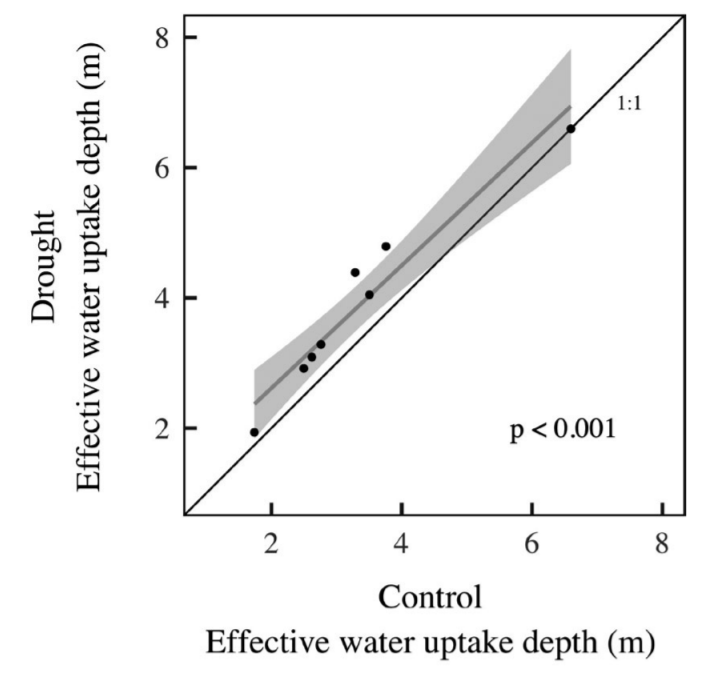September 01, 2021
Roots Dig Deep During Drought in Tropical Forests
Shifting root water uptake to deeper soil depths under drought maintains tree water and carbon cycling in wet-tropical forest trees.

Modeled rooting depths for wet-tropical trees in a drought plot (vertical axis) versus a neighboring control plot (horizontal axis). Trees in the drought plot consistently foraged for water deeper in the soil than trees in the neighboring control plot.
[Reprinted with permission from Pivovaroff, A.L., et al. "Stability of Tropical Forest Tree Carbon‐Water Relations in a Rainfall Exclusion Treatment through Shifts in Effective Water Uptake Depth." Global Change Biology 27 6454-6466 (2021). [DOI: 10.1111/gcb.15869] © 2022 John Wiley & Sons Ltd.]
The Science
This study examined how tropical rainforest trees respond to artificially induced drought. A canopy crane located in Queensland, Australia, was used to measure a variety of aboveground plant traits, such as leaf photosynthesis and transpiration. These measurements were used in an optimization model to calculate shifts in tree rooting depth, revealing that trees maintained consistency in aboveground carbon and water cycling by increasing the soil depth in which they foraged for water.
The Impact
Drought is the major culprit of tropical tree mortality, which has major implications for the carbon cycle. As droughts are anticipated to become more frequent and severe globally, being able to predict the risk of tree death and associated potential impact to forest carbon storage is critical. These results point to tree rooting depth as a key trait for understanding and predicting future tree responses to drought, and further suggest that tropical forests may be more resilient to drought than previously anticipated.
Summary
Drought increases tropical tree mortality, with large implications for the global water and carbon cycles. Yet how tropical trees respond to drought, specifically how they can mitigate drought impacts, is not fully understood. Through an experimentally-imposed, multi-year drought, this study discovered that wet-tropical trees can maintain function of aboveground traits, such as photosynthesis and transpiration. The trees achieve this apparent resilience to drought through increasing the soil depth at which they obtain water for transpiration. Drought caused declines in surface soil moisture content, but deeper soils maintained sufficient water to provide the tree’s transpirational requirements, leading to maintenance of canopy photosynthesis and transpiration. These results suggest that tropical trees can withstand a certain degree of drought through shifting their roots to deeper soil depths where water is more plentiful.
Principal Investigator
Alexandria Pivovaroff
Pacific Northwest National Laboratory
[email protected]
Program Manager
Brian Benscoter
U.S. Department of Energy, Biological and Environmental Research (SC-33)
Environmental System Science
[email protected]
Funding
This research was supported as part of the Next Generation Ecosystem Experiments–Tropics (NGEE–Tropics), funded by the Biological and Environmental Research (BER) Program within the U.S. Department of Energy’s (DOE) Office of Science.
References
Pivovaroff, A.L., et al. "Stability of Tropical Forest Tree Carbon‐Water Relations in a Rainfall Exclusion Treatment through Shifts in Effective Water Uptake Depth." Global Change Biology 27 6454-6466 (2021). https://doi.org/10.1111/gcb.15869.

